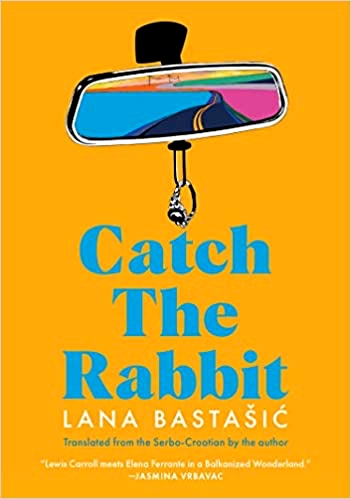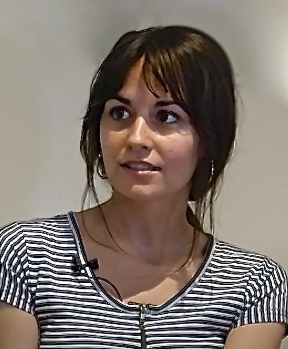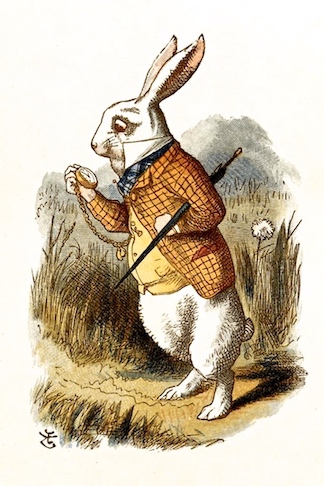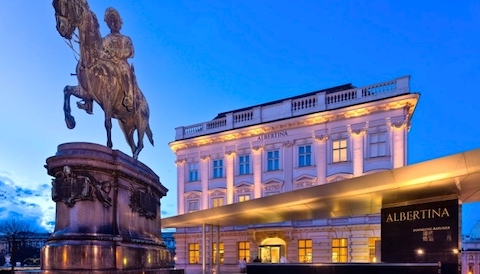Note: This novel was WINNER of the 2020 European Union Prize for Literature.
“Even now, within this text, I can almost feel her fidget. If she could, she would sneak between two sentences like a moth between two slats of a Venetian blind, and would finish my story off from the inside. She would change into the sparkly rags she always liked…add some waves to her hair. Me she would disfigure, leaving a single lock of hair on my square head…think up an inherent deformity so I keep dropping the pencil.” – Sara, referring to Lejla
 In this absorbing and constantly surprising metafictional novel,Yugoslavian author Lana Bastašić tells the history of a complex friendship between two women from their early years as children in Bosnia through their schooling, part of their college years, and ultimately when they are in their early thirties. Told so realistically that the narrator comes totally alive, and even inspires the reader to identify with her, the story of Sara and her friend Lejla follows a circular pattern, rotating through their lives, adding to the information the reader accepts as real, and establishing themes. Literary references, especially to Alice in Wonderland, add depth and reflect the author’s attitudes, as the constantly changing friendship between the two young women parallels the changing times, values, and sometimes other-worldly feelings of the two women.
In this absorbing and constantly surprising metafictional novel,Yugoslavian author Lana Bastašić tells the history of a complex friendship between two women from their early years as children in Bosnia through their schooling, part of their college years, and ultimately when they are in their early thirties. Told so realistically that the narrator comes totally alive, and even inspires the reader to identify with her, the story of Sara and her friend Lejla follows a circular pattern, rotating through their lives, adding to the information the reader accepts as real, and establishing themes. Literary references, especially to Alice in Wonderland, add depth and reflect the author’s attitudes, as the constantly changing friendship between the two young women parallels the changing times, values, and sometimes other-worldly feelings of the two women.
Sara, who eventually leaves Bosnia to continue her college education in Dublin, settles down there, rejecting everything associated with her past, even including her native language. She begins a new life, sharing it with Michael, a computer specialist, while she works as a writer and editor. Twelve years after she has lost contact with Lejla, she receives a surprising telephone call from her, insisting that Sara come to Bosnia immediately to pick her up so they can drive to Vienna where Lejla’s brother Armin, thought missing in the Bosnian War, twenty years ago, has been found alive. It is the reference to Armin which makes Sara decide to help Lejla deal with this unexpected and demanding task, even after all these years. She has always had a secret love for Armin. Almost immediately, she is packing up what she’ll need for her trip from Dublin to Bosnia and then the long drive from Bosnia to Vienna.
As she prepares to meet Lejla, the time and place shift, and Sara remembers visiting Lejla at her home a few days after Sara’s college graduation. Lejla’s pet rabbit has just died, and she wants help in burying him and in having Sara, then a budding poet, deliver a eulogy “to poisoned rabbits.” For Lejla, “life was a rabid fox coming at night to steal your chickens…[and] writing about life meant staring at the slaughtered [chickens] the next day, forever unable to catch the beast at its crime.” For Sara, however, “The fox had already run away,” and she knows that “I couldn’t catch it.” They are clearly operating on different planes as Lejla ultimately jokes about the rabbit that Sara remembers Lejla loving more than people. Now what matters most to Lejla is that “Bunny got his epilogue,” contributed by Sara. Life, death, meaning, and their interrelationships, established early, echo again and again throughout the novel, and the aphorism – “Catch the Rabbit” – not only gives life to the stories of their friendship but also illustrates their differences in goals and values.

The catacombs of Bosnia, “A malificent name for a maleficent little house standing above a hole in the ground.”
When she begins her car trip from Bosnia with Lejla, Sara notes that “a road-trip story makes sense only when the travelers, albeit wrongly, believe in reaching the finish line, the journey’s end that will solve all problems and end all misery. There’s no finish line in Bosnia, all roads seem to be equally languid and pointless; they lead you in circles even when it looks like you’re making progress.” A stop to spend the night at the home of an older friend from Jajce leads Lejla to resort to trickery, pretending that Sara does not speak their language, and she talks over Sara’s head, making fun of her to the woman while Sara, exhausted, just wishes to find a bed and sleep. Then Lejla decides she wants to see the catacombs, “a maleficent name for a maleficent little house standing above a hole in the ground,” a place where Tito was said to have hidden during World War II. As Lejla inspects the holes and the wounds on the walls, Sara believes it is all “crap to attract tourists.” Another rotation of the narrative, and Sara is remembering the cruelty and bullying by young school children to each other and to animals, with the boys playing catch in the snow with an injured infant sparrow with a broken wing and a crooked leg. When the question arises as to who is going to put the tiny bird out of its misery, none of the boys respond. It is Sara’s behavior which permanently changes perceptions of her.
Sara and Lejla continue their trip as each comes to new realizations about the other, and they both recall events with which readers will easily identify – the prom, discovering sex, socializing, and working to get their diplomas. But as they pass through the town in which they both grew up, Sara has an experience with her elderly mother which permanently affects her view of the world. Another experience on “the island” also reminds Sara of the trauma of growing up, and she soon begins to see how different she and Lejla really are. When Sara and Lejla finally arrive in Vienna, Sara regards the city as “swollen like a corpse,” and she does not trust it. Ultimately, she and Lejla decide to visit the Albertina Museum in Vienna, where they are lucky enough to see Albrecht Durer’s watercolor of a hare, painted in 1502, an event which leads to the thematic climax of the novel.
It is easy to see why this novel won the 2020 European Union Prize for Literature. Though it is a debut novel, author Lana Bastašić writes with such confidence and élan, such devotion to her themes and her characters, and such intense desire to communicate her ideas, that I found myself reading much of this book twice, enjoying new discoveries upon the second or third reading about particular events. The Bosnian War echoes throughout much of the novel, but it is peripheral to the wars that are happening within some of the characters, whose lives are so open that the reader cannot help but identify with them. Though there are some aspects of the book that could be tightened a bit for clarity, that issue is almost irrelevant in relation to the overall grandeur of the novel and its message. On my Favorites List for the year.
Photos: The author’s photo appears on https://www.euprizeliterature.eu
Lewis Carroll’s White Rabbit from Alice in Wonderland may be found here: https://www.etsy.com
The catacombs of Bosnia, “A malificent name for a maleficent little house standing above a hole in the ground.” https://www.alamy.com
Albert Durer’s watercolor of a hare, painted in 1502, is from https://www.wikiart.org
The Albertina Museum in Vienna appears on https://www.ukrinform.net




